Report on Microsoft's Organizational Structure, Culture, and Evolution
VerifiedAdded on 2023/06/14
|11
|2536
|101
Report
AI Summary
This report provides an in-depth analysis of Microsoft Corporation's organizational structure, focusing on the factors influencing its design, such as strategy, technology, people, and environment. It examines Microsoft's divisional structure, highlighting characteristics like product type divisions, global corporate groups, and geographic segments. The report explores organizational culture theories, including product type divisional culture and clan culture, and their impact on growth and evolution. Additionally, it delves into leadership theories, such as transformational and situational leadership, and their role in motivating and driving performance. Finally, the relationship between innovation and organizational growth is discussed, emphasizing the importance of incremental and disruptive innovation strategies for sustained evolution. The report concludes by highlighting the critical role of Microsoft's organizational culture in its present performance and innovation levels.
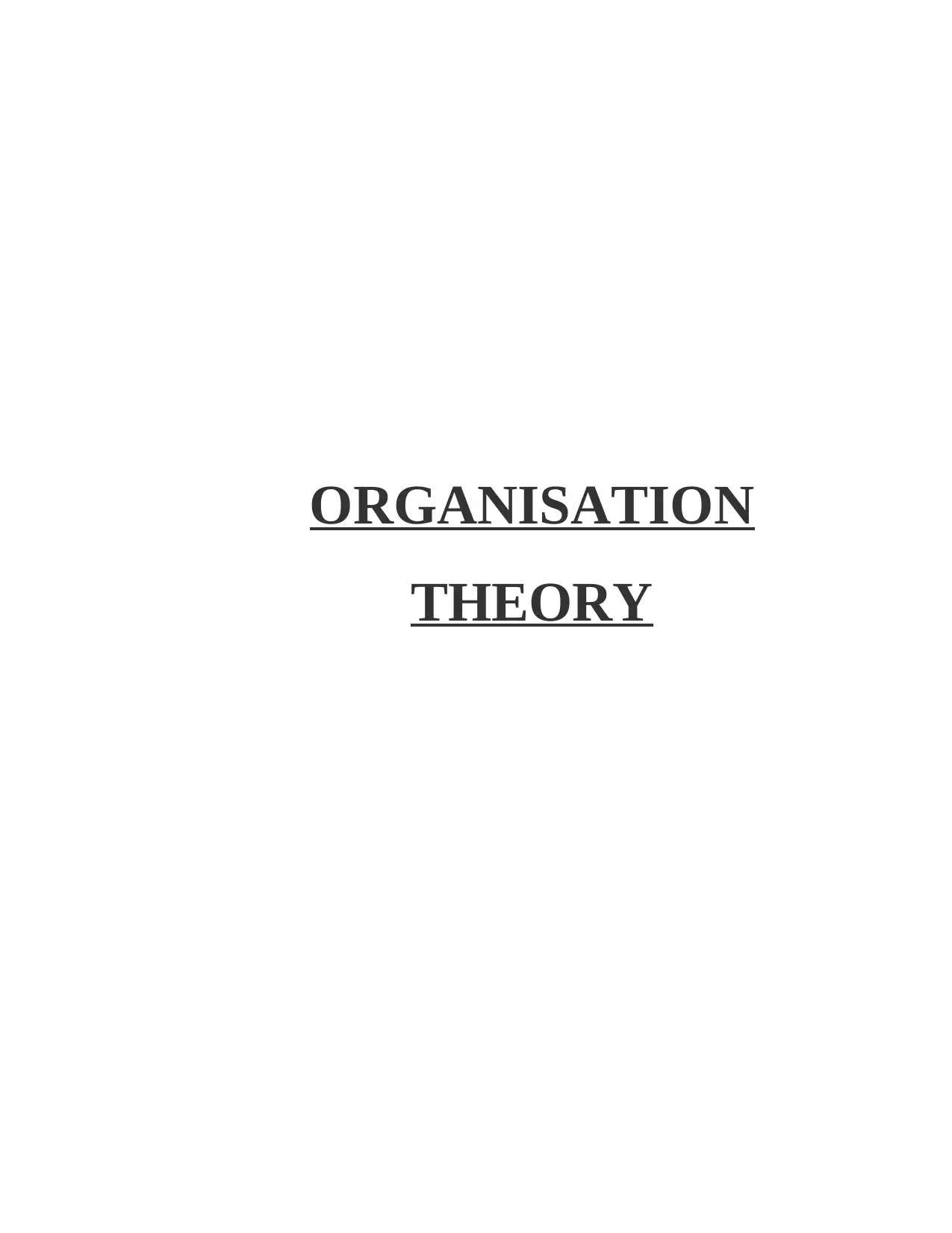
ORGANISATION
THEORY
THEORY
Paraphrase This Document
Need a fresh take? Get an instant paraphrase of this document with our AI Paraphraser
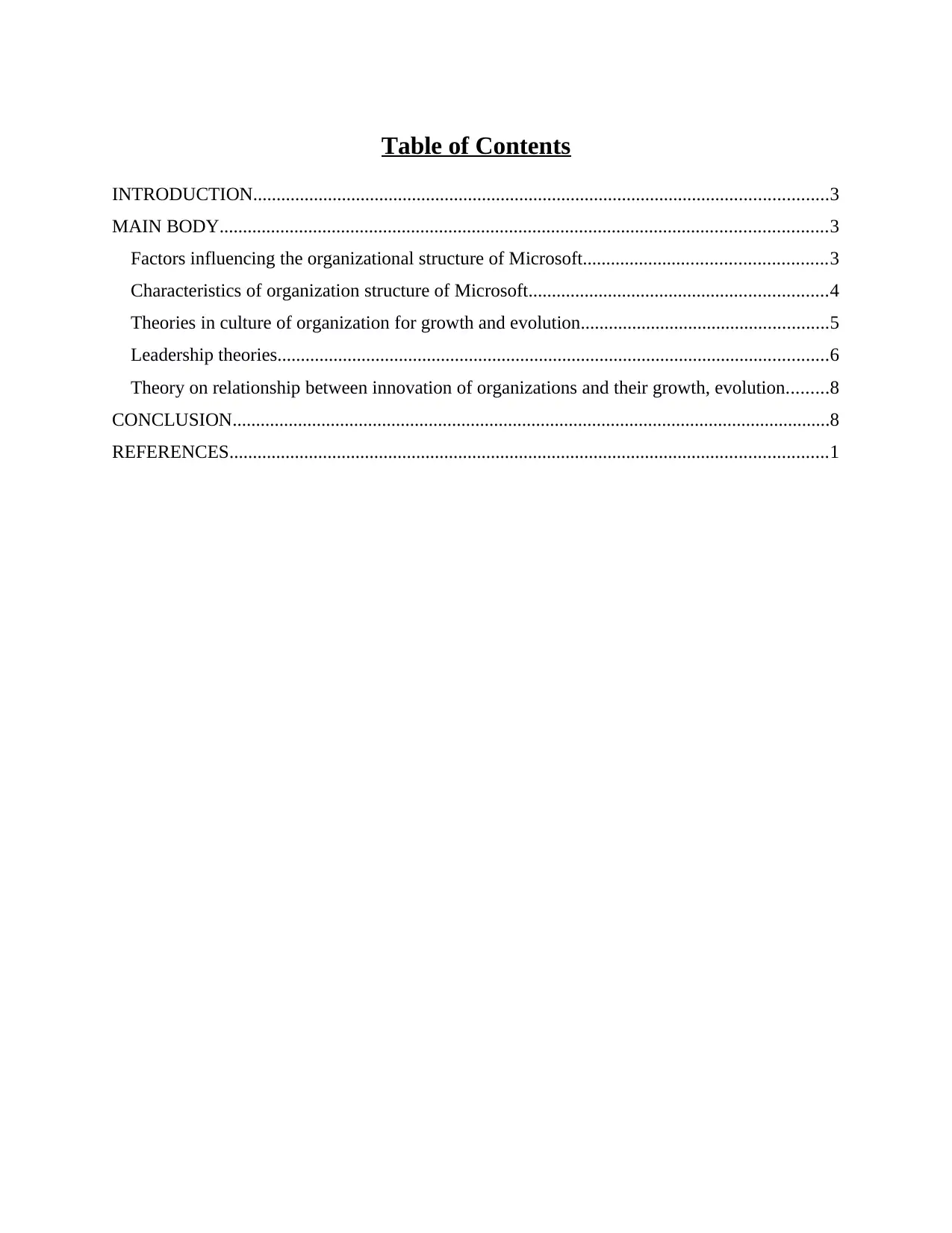
Table of Contents
INTRODUCTION...........................................................................................................................3
MAIN BODY..................................................................................................................................3
Factors influencing the organizational structure of Microsoft....................................................3
Characteristics of organization structure of Microsoft................................................................4
Theories in culture of organization for growth and evolution.....................................................5
Leadership theories......................................................................................................................6
Theory on relationship between innovation of organizations and their growth, evolution.........8
CONCLUSION................................................................................................................................8
REFERENCES................................................................................................................................1
INTRODUCTION...........................................................................................................................3
MAIN BODY..................................................................................................................................3
Factors influencing the organizational structure of Microsoft....................................................3
Characteristics of organization structure of Microsoft................................................................4
Theories in culture of organization for growth and evolution.....................................................5
Leadership theories......................................................................................................................6
Theory on relationship between innovation of organizations and their growth, evolution.........8
CONCLUSION................................................................................................................................8
REFERENCES................................................................................................................................1
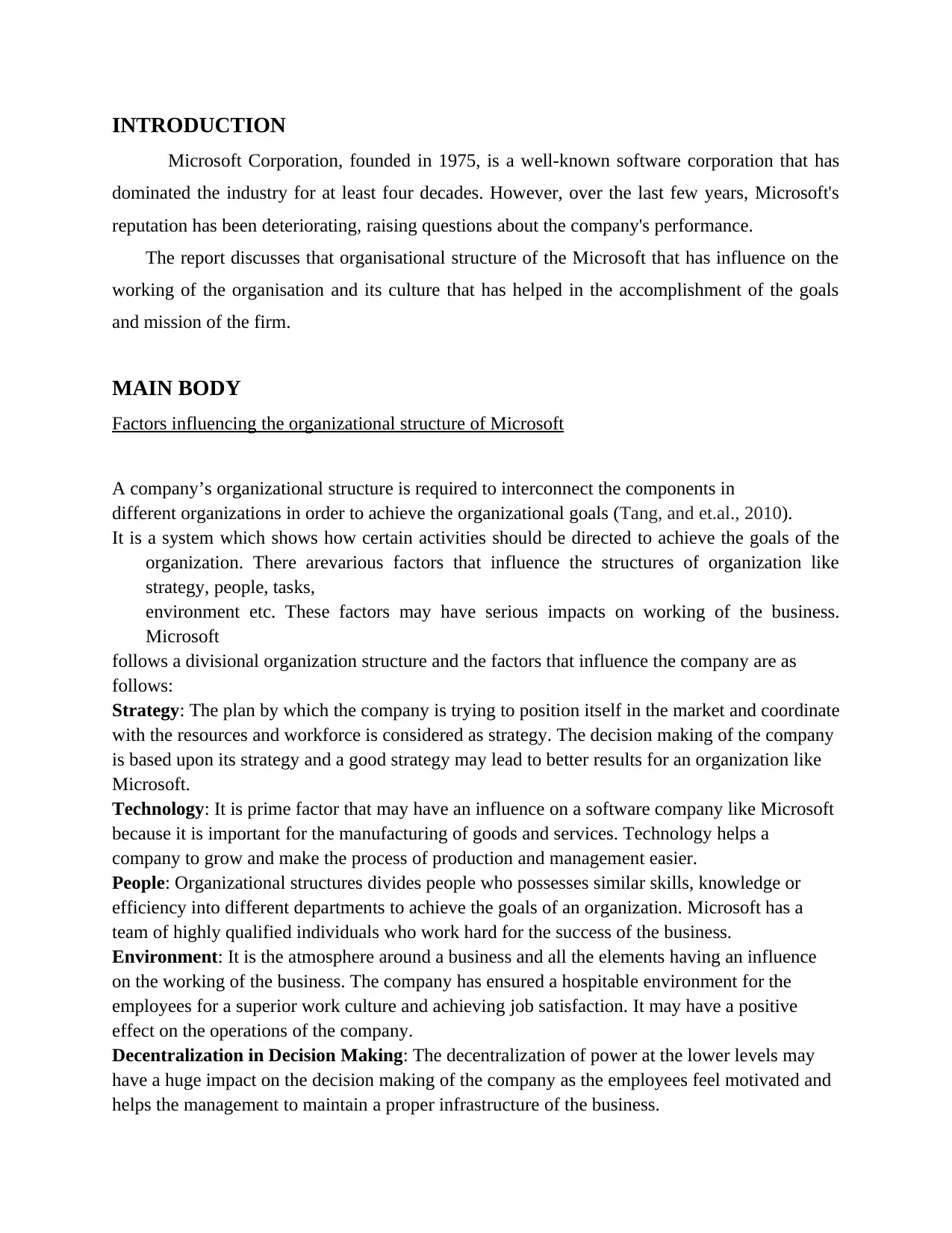
INTRODUCTION
Microsoft Corporation, founded in 1975, is a well-known software corporation that has
dominated the industry for at least four decades. However, over the last few years, Microsoft's
reputation has been deteriorating, raising questions about the company's performance.
The report discusses that organisational structure of the Microsoft that has influence on the
working of the organisation and its culture that has helped in the accomplishment of the goals
and mission of the firm.
MAIN BODY
Factors influencing the organizational structure of Microsoft
A company’s organizational structure is required to interconnect the components in
different organizations in order to achieve the organizational goals (Tang, and et.al., 2010).
It is a system which shows how certain activities should be directed to achieve the goals of the
organization. There arevarious factors that influence the structures of organization like
strategy, people, tasks,
environment etc. These factors may have serious impacts on working of the business.
Microsoft
follows a divisional organization structure and the factors that influence the company are as
follows:
Strategy: The plan by which the company is trying to position itself in the market and coordinate
with the resources and workforce is considered as strategy. The decision making of the company
is based upon its strategy and a good strategy may lead to better results for an organization like
Microsoft.
Technology: It is prime factor that may have an influence on a software company like Microsoft
because it is important for the manufacturing of goods and services. Technology helps a
company to grow and make the process of production and management easier.
People: Organizational structures divides people who possesses similar skills, knowledge or
efficiency into different departments to achieve the goals of an organization. Microsoft has a
team of highly qualified individuals who work hard for the success of the business.
Environment: It is the atmosphere around a business and all the elements having an influence
on the working of the business. The company has ensured a hospitable environment for the
employees for a superior work culture and achieving job satisfaction. It may have a positive
effect on the operations of the company.
Decentralization in Decision Making: The decentralization of power at the lower levels may
have a huge impact on the decision making of the company as the employees feel motivated and
helps the management to maintain a proper infrastructure of the business.
Microsoft Corporation, founded in 1975, is a well-known software corporation that has
dominated the industry for at least four decades. However, over the last few years, Microsoft's
reputation has been deteriorating, raising questions about the company's performance.
The report discusses that organisational structure of the Microsoft that has influence on the
working of the organisation and its culture that has helped in the accomplishment of the goals
and mission of the firm.
MAIN BODY
Factors influencing the organizational structure of Microsoft
A company’s organizational structure is required to interconnect the components in
different organizations in order to achieve the organizational goals (Tang, and et.al., 2010).
It is a system which shows how certain activities should be directed to achieve the goals of the
organization. There arevarious factors that influence the structures of organization like
strategy, people, tasks,
environment etc. These factors may have serious impacts on working of the business.
Microsoft
follows a divisional organization structure and the factors that influence the company are as
follows:
Strategy: The plan by which the company is trying to position itself in the market and coordinate
with the resources and workforce is considered as strategy. The decision making of the company
is based upon its strategy and a good strategy may lead to better results for an organization like
Microsoft.
Technology: It is prime factor that may have an influence on a software company like Microsoft
because it is important for the manufacturing of goods and services. Technology helps a
company to grow and make the process of production and management easier.
People: Organizational structures divides people who possesses similar skills, knowledge or
efficiency into different departments to achieve the goals of an organization. Microsoft has a
team of highly qualified individuals who work hard for the success of the business.
Environment: It is the atmosphere around a business and all the elements having an influence
on the working of the business. The company has ensured a hospitable environment for the
employees for a superior work culture and achieving job satisfaction. It may have a positive
effect on the operations of the company.
Decentralization in Decision Making: The decentralization of power at the lower levels may
have a huge impact on the decision making of the company as the employees feel motivated and
helps the management to maintain a proper infrastructure of the business.
⊘ This is a preview!⊘
Do you want full access?
Subscribe today to unlock all pages.

Trusted by 1+ million students worldwide
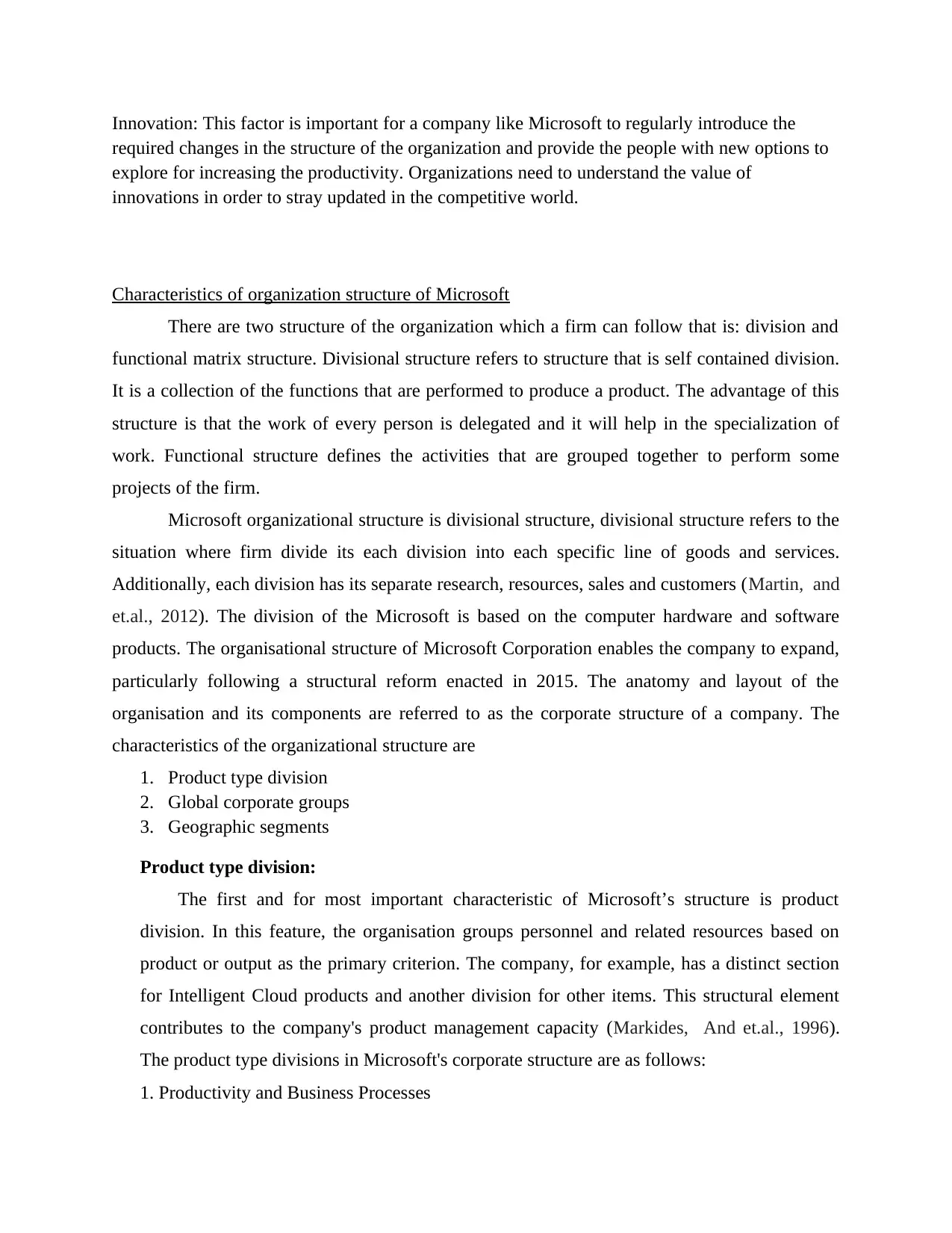
Innovation: This factor is important for a company like Microsoft to regularly introduce the
required changes in the structure of the organization and provide the people with new options to
explore for increasing the productivity. Organizations need to understand the value of
innovations in order to stray updated in the competitive world.
Characteristics of organization structure of Microsoft
There are two structure of the organization which a firm can follow that is: division and
functional matrix structure. Divisional structure refers to structure that is self contained division.
It is a collection of the functions that are performed to produce a product. The advantage of this
structure is that the work of every person is delegated and it will help in the specialization of
work. Functional structure defines the activities that are grouped together to perform some
projects of the firm.
Microsoft organizational structure is divisional structure, divisional structure refers to the
situation where firm divide its each division into each specific line of goods and services.
Additionally, each division has its separate research, resources, sales and customers (Martin, and
et.al., 2012). The division of the Microsoft is based on the computer hardware and software
products. The organisational structure of Microsoft Corporation enables the company to expand,
particularly following a structural reform enacted in 2015. The anatomy and layout of the
organisation and its components are referred to as the corporate structure of a company. The
characteristics of the organizational structure are
1. Product type division
2. Global corporate groups
3. Geographic segments
Product type division:
The first and for most important characteristic of Microsoft’s structure is product
division. In this feature, the organisation groups personnel and related resources based on
product or output as the primary criterion. The company, for example, has a distinct section
for Intelligent Cloud products and another division for other items. This structural element
contributes to the company's product management capacity (Markides, And et.al., 1996).
The product type divisions in Microsoft's corporate structure are as follows:
1. Productivity and Business Processes
required changes in the structure of the organization and provide the people with new options to
explore for increasing the productivity. Organizations need to understand the value of
innovations in order to stray updated in the competitive world.
Characteristics of organization structure of Microsoft
There are two structure of the organization which a firm can follow that is: division and
functional matrix structure. Divisional structure refers to structure that is self contained division.
It is a collection of the functions that are performed to produce a product. The advantage of this
structure is that the work of every person is delegated and it will help in the specialization of
work. Functional structure defines the activities that are grouped together to perform some
projects of the firm.
Microsoft organizational structure is divisional structure, divisional structure refers to the
situation where firm divide its each division into each specific line of goods and services.
Additionally, each division has its separate research, resources, sales and customers (Martin, and
et.al., 2012). The division of the Microsoft is based on the computer hardware and software
products. The organisational structure of Microsoft Corporation enables the company to expand,
particularly following a structural reform enacted in 2015. The anatomy and layout of the
organisation and its components are referred to as the corporate structure of a company. The
characteristics of the organizational structure are
1. Product type division
2. Global corporate groups
3. Geographic segments
Product type division:
The first and for most important characteristic of Microsoft’s structure is product
division. In this feature, the organisation groups personnel and related resources based on
product or output as the primary criterion. The company, for example, has a distinct section
for Intelligent Cloud products and another division for other items. This structural element
contributes to the company's product management capacity (Markides, And et.al., 1996).
The product type divisions in Microsoft's corporate structure are as follows:
1. Productivity and Business Processes
Paraphrase This Document
Need a fresh take? Get an instant paraphrase of this document with our AI Paraphraser
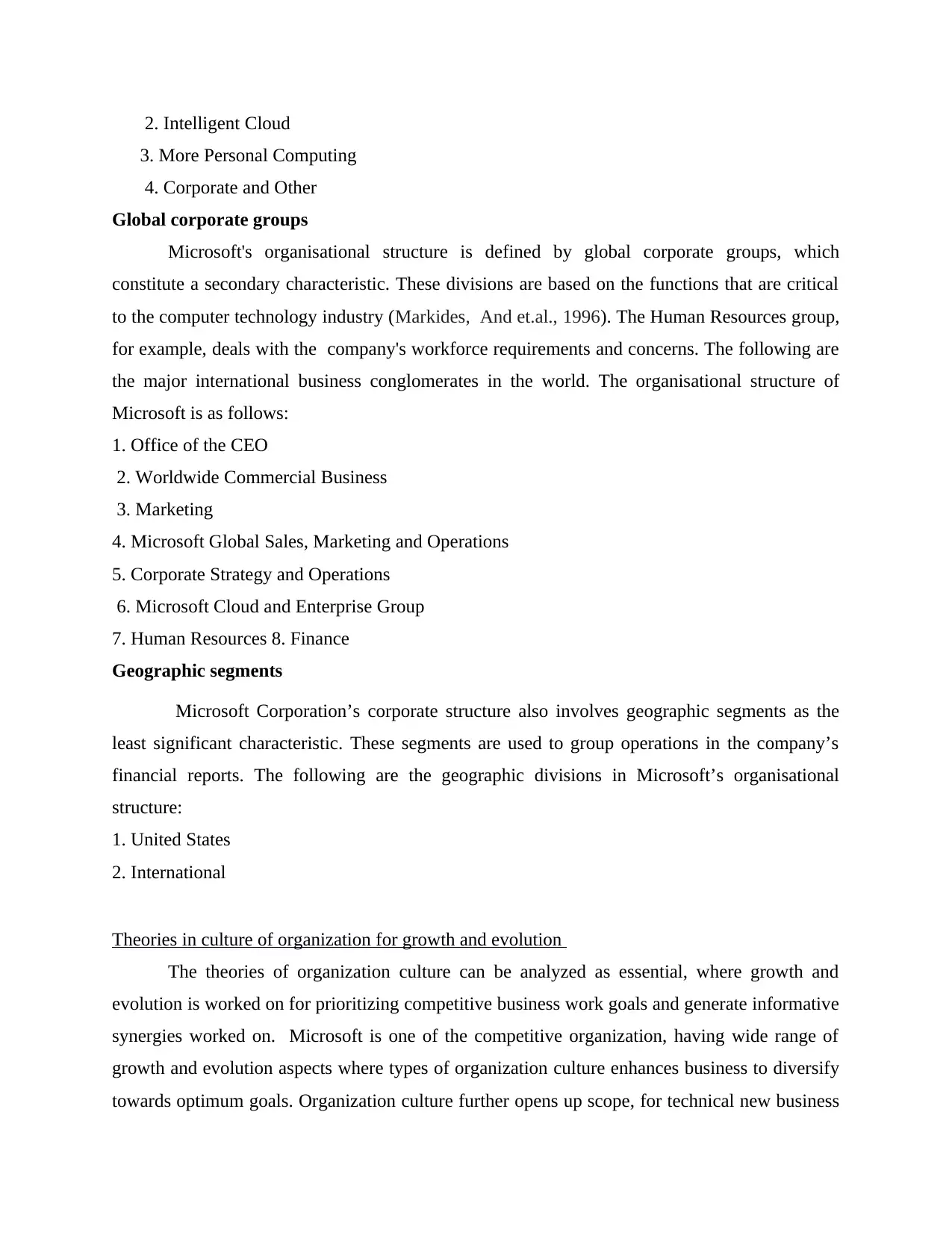
2. Intelligent Cloud
3. More Personal Computing
4. Corporate and Other
Global corporate groups
Microsoft's organisational structure is defined by global corporate groups, which
constitute a secondary characteristic. These divisions are based on the functions that are critical
to the computer technology industry (Markides, And et.al., 1996). The Human Resources group,
for example, deals with the company's workforce requirements and concerns. The following are
the major international business conglomerates in the world. The organisational structure of
Microsoft is as follows:
1. Office of the CEO
2. Worldwide Commercial Business
3. Marketing
4. Microsoft Global Sales, Marketing and Operations
5. Corporate Strategy and Operations
6. Microsoft Cloud and Enterprise Group
7. Human Resources 8. Finance
Geographic segments
Microsoft Corporation’s corporate structure also involves geographic segments as the
least significant characteristic. These segments are used to group operations in the company’s
financial reports. The following are the geographic divisions in Microsoft’s organisational
structure:
1. United States
2. International
Theories in culture of organization for growth and evolution
The theories of organization culture can be analyzed as essential, where growth and
evolution is worked on for prioritizing competitive business work goals and generate informative
synergies worked on. Microsoft is one of the competitive organization, having wide range of
growth and evolution aspects where types of organization culture enhances business to diversify
towards optimum goals. Organization culture further opens up scope, for technical new business
3. More Personal Computing
4. Corporate and Other
Global corporate groups
Microsoft's organisational structure is defined by global corporate groups, which
constitute a secondary characteristic. These divisions are based on the functions that are critical
to the computer technology industry (Markides, And et.al., 1996). The Human Resources group,
for example, deals with the company's workforce requirements and concerns. The following are
the major international business conglomerates in the world. The organisational structure of
Microsoft is as follows:
1. Office of the CEO
2. Worldwide Commercial Business
3. Marketing
4. Microsoft Global Sales, Marketing and Operations
5. Corporate Strategy and Operations
6. Microsoft Cloud and Enterprise Group
7. Human Resources 8. Finance
Geographic segments
Microsoft Corporation’s corporate structure also involves geographic segments as the
least significant characteristic. These segments are used to group operations in the company’s
financial reports. The following are the geographic divisions in Microsoft’s organisational
structure:
1. United States
2. International
Theories in culture of organization for growth and evolution
The theories of organization culture can be analyzed as essential, where growth and
evolution is worked on for prioritizing competitive business work goals and generate informative
synergies worked on. Microsoft is one of the competitive organization, having wide range of
growth and evolution aspects where types of organization culture enhances business to diversify
towards optimum goals. Organization culture further opens up scope, for technical new business
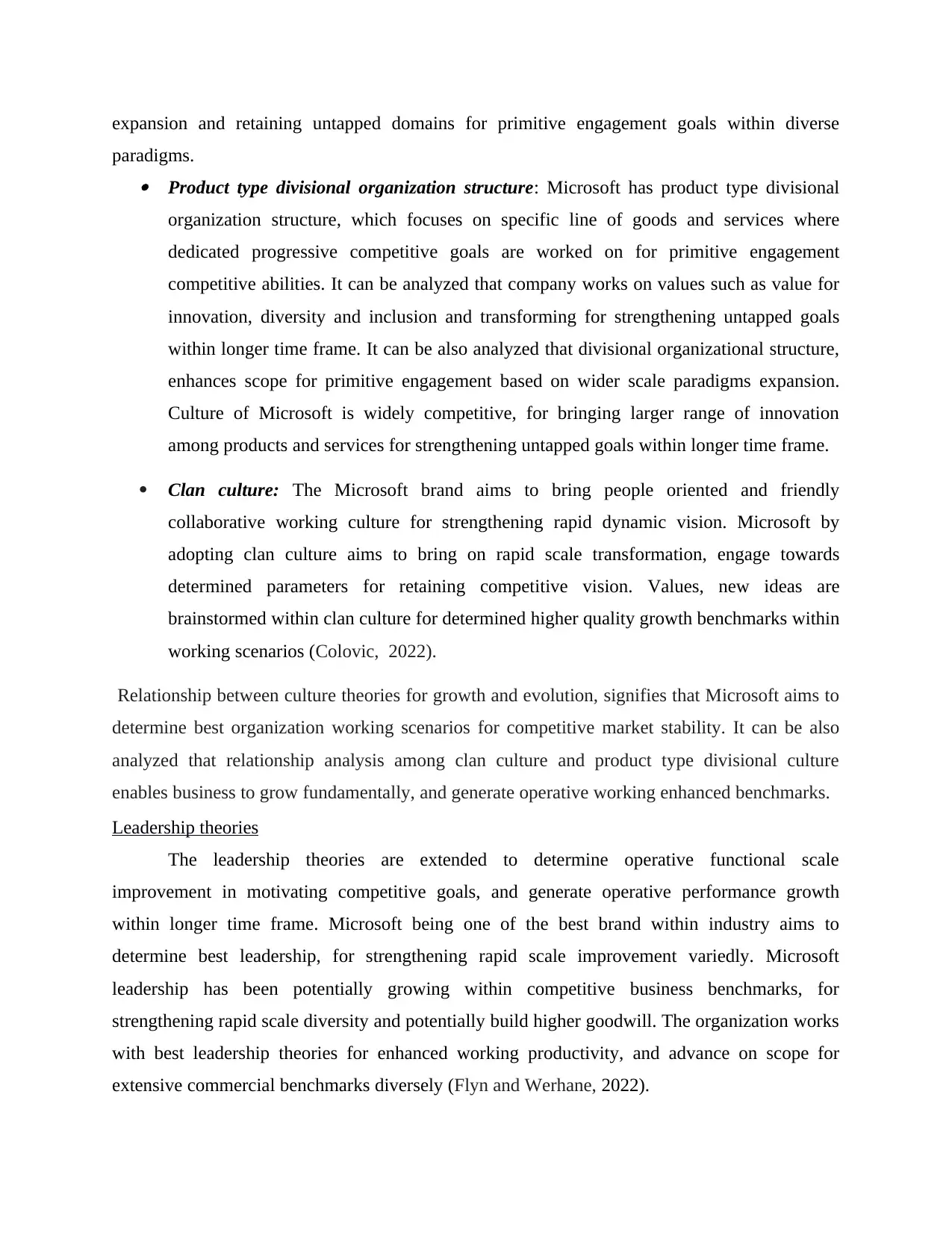
expansion and retaining untapped domains for primitive engagement goals within diverse
paradigms. Product type divisional organization structure: Microsoft has product type divisional
organization structure, which focuses on specific line of goods and services where
dedicated progressive competitive goals are worked on for primitive engagement
competitive abilities. It can be analyzed that company works on values such as value for
innovation, diversity and inclusion and transforming for strengthening untapped goals
within longer time frame. It can be also analyzed that divisional organizational structure,
enhances scope for primitive engagement based on wider scale paradigms expansion.
Culture of Microsoft is widely competitive, for bringing larger range of innovation
among products and services for strengthening untapped goals within longer time frame.
Clan culture: The Microsoft brand aims to bring people oriented and friendly
collaborative working culture for strengthening rapid dynamic vision. Microsoft by
adopting clan culture aims to bring on rapid scale transformation, engage towards
determined parameters for retaining competitive vision. Values, new ideas are
brainstormed within clan culture for determined higher quality growth benchmarks within
working scenarios (Colovic, 2022).
Relationship between culture theories for growth and evolution, signifies that Microsoft aims to
determine best organization working scenarios for competitive market stability. It can be also
analyzed that relationship analysis among clan culture and product type divisional culture
enables business to grow fundamentally, and generate operative working enhanced benchmarks.
Leadership theories
The leadership theories are extended to determine operative functional scale
improvement in motivating competitive goals, and generate operative performance growth
within longer time frame. Microsoft being one of the best brand within industry aims to
determine best leadership, for strengthening rapid scale improvement variedly. Microsoft
leadership has been potentially growing within competitive business benchmarks, for
strengthening rapid scale diversity and potentially build higher goodwill. The organization works
with best leadership theories for enhanced working productivity, and advance on scope for
extensive commercial benchmarks diversely (Flyn and Werhane, 2022).
paradigms. Product type divisional organization structure: Microsoft has product type divisional
organization structure, which focuses on specific line of goods and services where
dedicated progressive competitive goals are worked on for primitive engagement
competitive abilities. It can be analyzed that company works on values such as value for
innovation, diversity and inclusion and transforming for strengthening untapped goals
within longer time frame. It can be also analyzed that divisional organizational structure,
enhances scope for primitive engagement based on wider scale paradigms expansion.
Culture of Microsoft is widely competitive, for bringing larger range of innovation
among products and services for strengthening untapped goals within longer time frame.
Clan culture: The Microsoft brand aims to bring people oriented and friendly
collaborative working culture for strengthening rapid dynamic vision. Microsoft by
adopting clan culture aims to bring on rapid scale transformation, engage towards
determined parameters for retaining competitive vision. Values, new ideas are
brainstormed within clan culture for determined higher quality growth benchmarks within
working scenarios (Colovic, 2022).
Relationship between culture theories for growth and evolution, signifies that Microsoft aims to
determine best organization working scenarios for competitive market stability. It can be also
analyzed that relationship analysis among clan culture and product type divisional culture
enables business to grow fundamentally, and generate operative working enhanced benchmarks.
Leadership theories
The leadership theories are extended to determine operative functional scale
improvement in motivating competitive goals, and generate operative performance growth
within longer time frame. Microsoft being one of the best brand within industry aims to
determine best leadership, for strengthening rapid scale improvement variedly. Microsoft
leadership has been potentially growing within competitive business benchmarks, for
strengthening rapid scale diversity and potentially build higher goodwill. The organization works
with best leadership theories for enhanced working productivity, and advance on scope for
extensive commercial benchmarks diversely (Flyn and Werhane, 2022).
⊘ This is a preview!⊘
Do you want full access?
Subscribe today to unlock all pages.

Trusted by 1+ million students worldwide
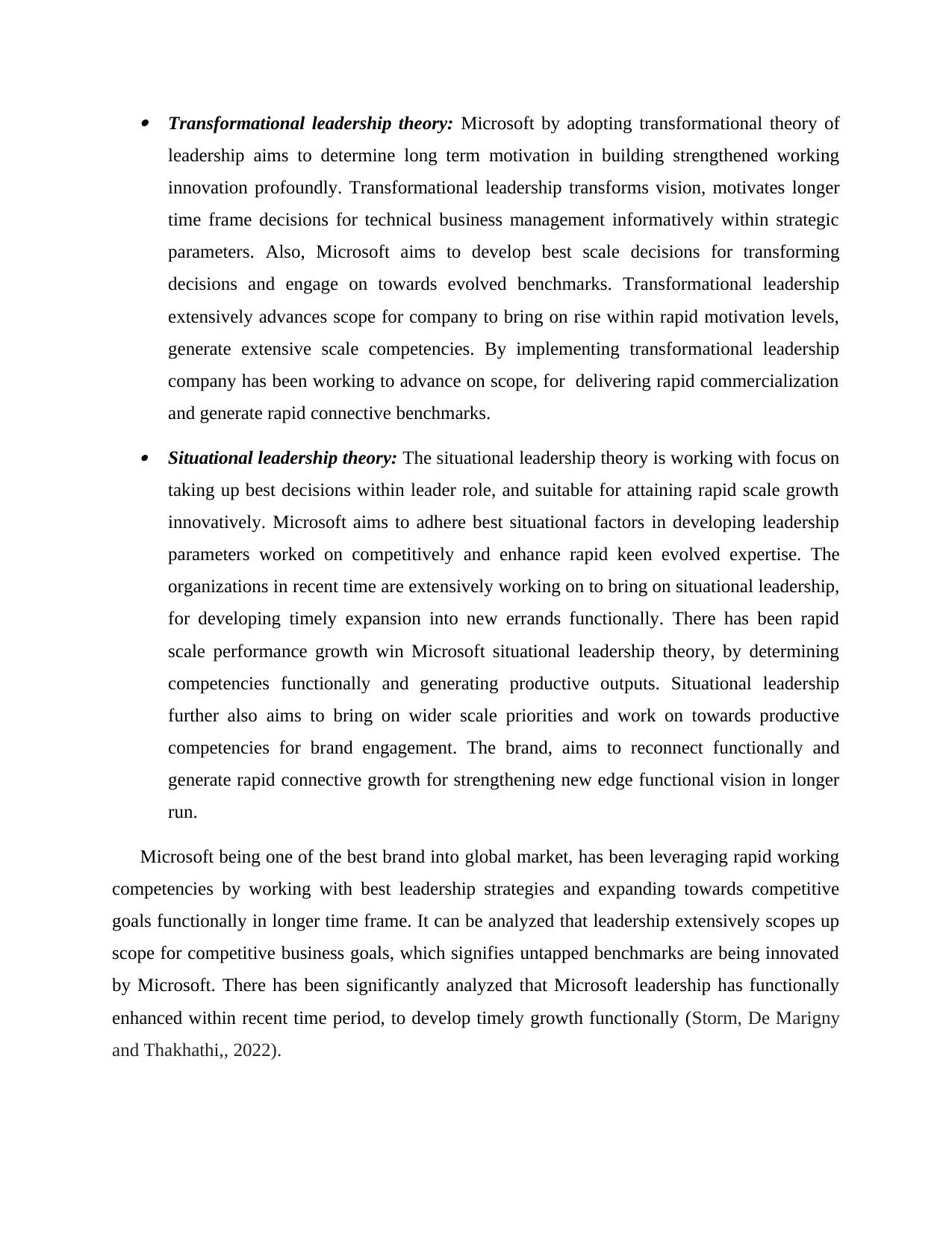
Transformational leadership theory: Microsoft by adopting transformational theory of
leadership aims to determine long term motivation in building strengthened working
innovation profoundly. Transformational leadership transforms vision, motivates longer
time frame decisions for technical business management informatively within strategic
parameters. Also, Microsoft aims to develop best scale decisions for transforming
decisions and engage on towards evolved benchmarks. Transformational leadership
extensively advances scope for company to bring on rise within rapid motivation levels,
generate extensive scale competencies. By implementing transformational leadership
company has been working to advance on scope, for delivering rapid commercialization
and generate rapid connective benchmarks. Situational leadership theory: The situational leadership theory is working with focus on
taking up best decisions within leader role, and suitable for attaining rapid scale growth
innovatively. Microsoft aims to adhere best situational factors in developing leadership
parameters worked on competitively and enhance rapid keen evolved expertise. The
organizations in recent time are extensively working on to bring on situational leadership,
for developing timely expansion into new errands functionally. There has been rapid
scale performance growth win Microsoft situational leadership theory, by determining
competencies functionally and generating productive outputs. Situational leadership
further also aims to bring on wider scale priorities and work on towards productive
competencies for brand engagement. The brand, aims to reconnect functionally and
generate rapid connective growth for strengthening new edge functional vision in longer
run.
Microsoft being one of the best brand into global market, has been leveraging rapid working
competencies by working with best leadership strategies and expanding towards competitive
goals functionally in longer time frame. It can be analyzed that leadership extensively scopes up
scope for competitive business goals, which signifies untapped benchmarks are being innovated
by Microsoft. There has been significantly analyzed that Microsoft leadership has functionally
enhanced within recent time period, to develop timely growth functionally (Storm, De Marigny
and Thakhathi,, 2022).
leadership aims to determine long term motivation in building strengthened working
innovation profoundly. Transformational leadership transforms vision, motivates longer
time frame decisions for technical business management informatively within strategic
parameters. Also, Microsoft aims to develop best scale decisions for transforming
decisions and engage on towards evolved benchmarks. Transformational leadership
extensively advances scope for company to bring on rise within rapid motivation levels,
generate extensive scale competencies. By implementing transformational leadership
company has been working to advance on scope, for delivering rapid commercialization
and generate rapid connective benchmarks. Situational leadership theory: The situational leadership theory is working with focus on
taking up best decisions within leader role, and suitable for attaining rapid scale growth
innovatively. Microsoft aims to adhere best situational factors in developing leadership
parameters worked on competitively and enhance rapid keen evolved expertise. The
organizations in recent time are extensively working on to bring on situational leadership,
for developing timely expansion into new errands functionally. There has been rapid
scale performance growth win Microsoft situational leadership theory, by determining
competencies functionally and generating productive outputs. Situational leadership
further also aims to bring on wider scale priorities and work on towards productive
competencies for brand engagement. The brand, aims to reconnect functionally and
generate rapid connective growth for strengthening new edge functional vision in longer
run.
Microsoft being one of the best brand into global market, has been leveraging rapid working
competencies by working with best leadership strategies and expanding towards competitive
goals functionally in longer time frame. It can be analyzed that leadership extensively scopes up
scope for competitive business goals, which signifies untapped benchmarks are being innovated
by Microsoft. There has been significantly analyzed that Microsoft leadership has functionally
enhanced within recent time period, to develop timely growth functionally (Storm, De Marigny
and Thakhathi,, 2022).
Paraphrase This Document
Need a fresh take? Get an instant paraphrase of this document with our AI Paraphraser
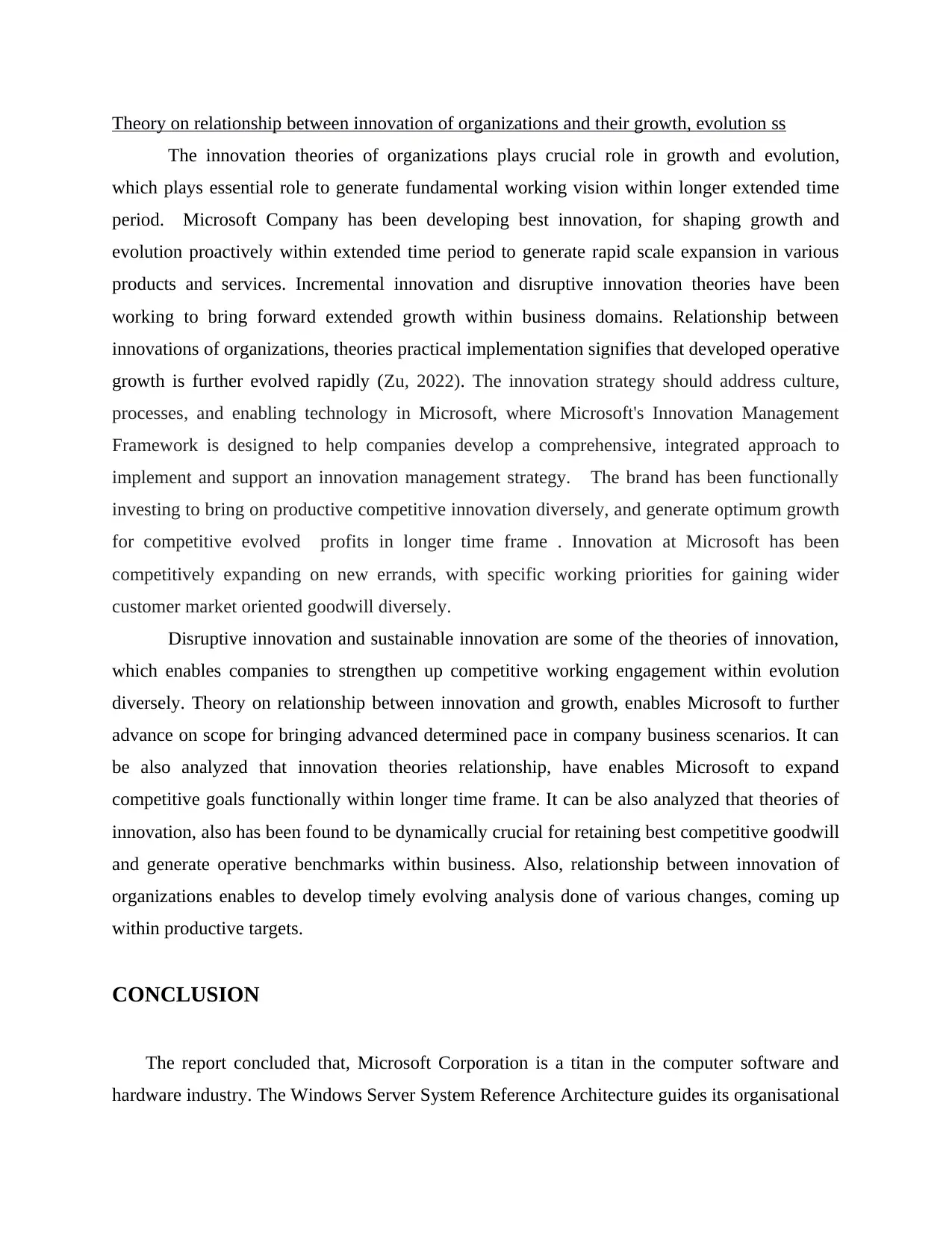
Theory on relationship between innovation of organizations and their growth, evolution ss
The innovation theories of organizations plays crucial role in growth and evolution,
which plays essential role to generate fundamental working vision within longer extended time
period. Microsoft Company has been developing best innovation, for shaping growth and
evolution proactively within extended time period to generate rapid scale expansion in various
products and services. Incremental innovation and disruptive innovation theories have been
working to bring forward extended growth within business domains. Relationship between
innovations of organizations, theories practical implementation signifies that developed operative
growth is further evolved rapidly (Zu, 2022). The innovation strategy should address culture,
processes, and enabling technology in Microsoft, where Microsoft's Innovation Management
Framework is designed to help companies develop a comprehensive, integrated approach to
implement and support an innovation management strategy. The brand has been functionally
investing to bring on productive competitive innovation diversely, and generate optimum growth
for competitive evolved profits in longer time frame . Innovation at Microsoft has been
competitively expanding on new errands, with specific working priorities for gaining wider
customer market oriented goodwill diversely.
Disruptive innovation and sustainable innovation are some of the theories of innovation,
which enables companies to strengthen up competitive working engagement within evolution
diversely. Theory on relationship between innovation and growth, enables Microsoft to further
advance on scope for bringing advanced determined pace in company business scenarios. It can
be also analyzed that innovation theories relationship, have enables Microsoft to expand
competitive goals functionally within longer time frame. It can be also analyzed that theories of
innovation, also has been found to be dynamically crucial for retaining best competitive goodwill
and generate operative benchmarks within business. Also, relationship between innovation of
organizations enables to develop timely evolving analysis done of various changes, coming up
within productive targets.
CONCLUSION
The report concluded that, Microsoft Corporation is a titan in the computer software and
hardware industry. The Windows Server System Reference Architecture guides its organisational
The innovation theories of organizations plays crucial role in growth and evolution,
which plays essential role to generate fundamental working vision within longer extended time
period. Microsoft Company has been developing best innovation, for shaping growth and
evolution proactively within extended time period to generate rapid scale expansion in various
products and services. Incremental innovation and disruptive innovation theories have been
working to bring forward extended growth within business domains. Relationship between
innovations of organizations, theories practical implementation signifies that developed operative
growth is further evolved rapidly (Zu, 2022). The innovation strategy should address culture,
processes, and enabling technology in Microsoft, where Microsoft's Innovation Management
Framework is designed to help companies develop a comprehensive, integrated approach to
implement and support an innovation management strategy. The brand has been functionally
investing to bring on productive competitive innovation diversely, and generate optimum growth
for competitive evolved profits in longer time frame . Innovation at Microsoft has been
competitively expanding on new errands, with specific working priorities for gaining wider
customer market oriented goodwill diversely.
Disruptive innovation and sustainable innovation are some of the theories of innovation,
which enables companies to strengthen up competitive working engagement within evolution
diversely. Theory on relationship between innovation and growth, enables Microsoft to further
advance on scope for bringing advanced determined pace in company business scenarios. It can
be also analyzed that innovation theories relationship, have enables Microsoft to expand
competitive goals functionally within longer time frame. It can be also analyzed that theories of
innovation, also has been found to be dynamically crucial for retaining best competitive goodwill
and generate operative benchmarks within business. Also, relationship between innovation of
organizations enables to develop timely evolving analysis done of various changes, coming up
within productive targets.
CONCLUSION
The report concluded that, Microsoft Corporation is a titan in the computer software and
hardware industry. The Windows Server System Reference Architecture guides its organisational
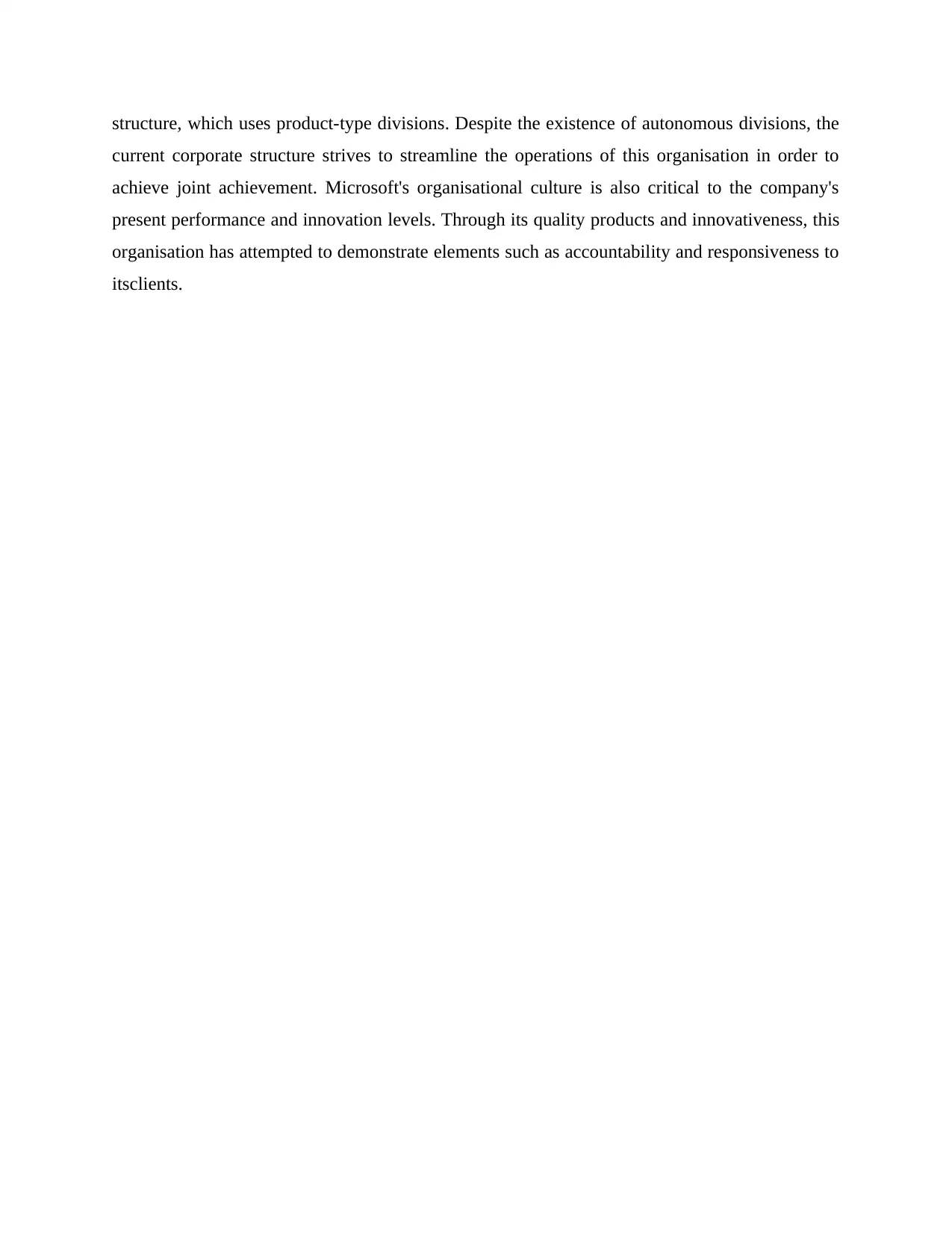
structure, which uses product-type divisions. Despite the existence of autonomous divisions, the
current corporate structure strives to streamline the operations of this organisation in order to
achieve joint achievement. Microsoft's organisational culture is also critical to the company's
present performance and innovation levels. Through its quality products and innovativeness, this
organisation has attempted to demonstrate elements such as accountability and responsiveness to
itsclients.
current corporate structure strives to streamline the operations of this organisation in order to
achieve joint achievement. Microsoft's organisational culture is also critical to the company's
present performance and innovation levels. Through its quality products and innovativeness, this
organisation has attempted to demonstrate elements such as accountability and responsiveness to
itsclients.
⊘ This is a preview!⊘
Do you want full access?
Subscribe today to unlock all pages.

Trusted by 1+ million students worldwide
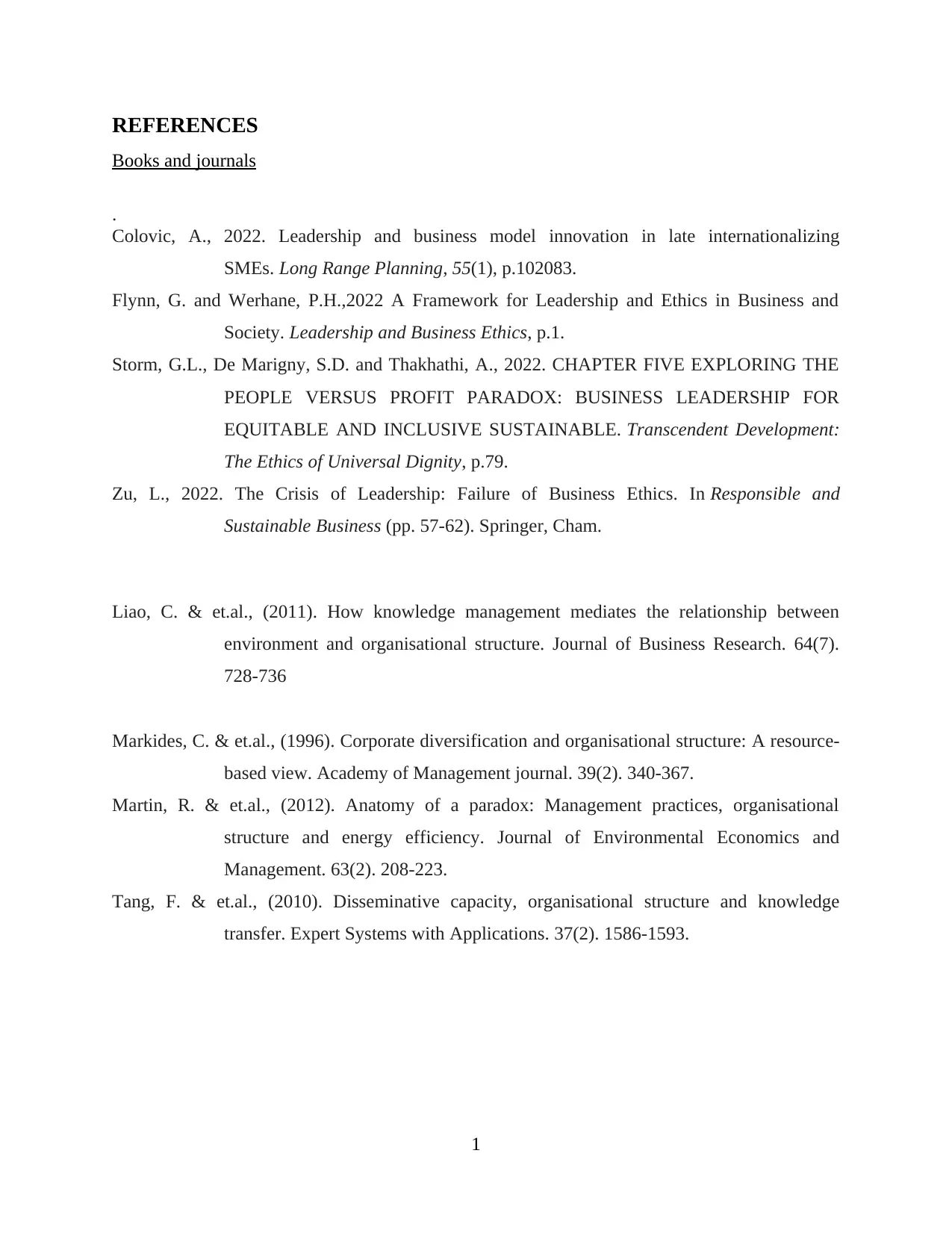
REFERENCES
Books and journals
.
Colovic, A., 2022. Leadership and business model innovation in late internationalizing
SMEs. Long Range Planning, 55(1), p.102083.
Flynn, G. and Werhane, P.H.,2022 A Framework for Leadership and Ethics in Business and
Society. Leadership and Business Ethics, p.1.
Storm, G.L., De Marigny, S.D. and Thakhathi, A., 2022. CHAPTER FIVE EXPLORING THE
PEOPLE VERSUS PROFIT PARADOX: BUSINESS LEADERSHIP FOR
EQUITABLE AND INCLUSIVE SUSTAINABLE. Transcendent Development:
The Ethics of Universal Dignity, p.79.
Zu, L., 2022. The Crisis of Leadership: Failure of Business Ethics. In Responsible and
Sustainable Business (pp. 57-62). Springer, Cham.
Liao, C. & et.al., (2011). How knowledge management mediates the relationship between
environment and organisational structure. Journal of Business Research. 64(7).
728-736
Markides, C. & et.al., (1996). Corporate diversification and organisational structure: A resource-
based view. Academy of Management journal. 39(2). 340-367.
Martin, R. & et.al., (2012). Anatomy of a paradox: Management practices, organisational
structure and energy efficiency. Journal of Environmental Economics and
Management. 63(2). 208-223.
Tang, F. & et.al., (2010). Disseminative capacity, organisational structure and knowledge
transfer. Expert Systems with Applications. 37(2). 1586-1593.
1
Books and journals
.
Colovic, A., 2022. Leadership and business model innovation in late internationalizing
SMEs. Long Range Planning, 55(1), p.102083.
Flynn, G. and Werhane, P.H.,2022 A Framework for Leadership and Ethics in Business and
Society. Leadership and Business Ethics, p.1.
Storm, G.L., De Marigny, S.D. and Thakhathi, A., 2022. CHAPTER FIVE EXPLORING THE
PEOPLE VERSUS PROFIT PARADOX: BUSINESS LEADERSHIP FOR
EQUITABLE AND INCLUSIVE SUSTAINABLE. Transcendent Development:
The Ethics of Universal Dignity, p.79.
Zu, L., 2022. The Crisis of Leadership: Failure of Business Ethics. In Responsible and
Sustainable Business (pp. 57-62). Springer, Cham.
Liao, C. & et.al., (2011). How knowledge management mediates the relationship between
environment and organisational structure. Journal of Business Research. 64(7).
728-736
Markides, C. & et.al., (1996). Corporate diversification and organisational structure: A resource-
based view. Academy of Management journal. 39(2). 340-367.
Martin, R. & et.al., (2012). Anatomy of a paradox: Management practices, organisational
structure and energy efficiency. Journal of Environmental Economics and
Management. 63(2). 208-223.
Tang, F. & et.al., (2010). Disseminative capacity, organisational structure and knowledge
transfer. Expert Systems with Applications. 37(2). 1586-1593.
1
Paraphrase This Document
Need a fresh take? Get an instant paraphrase of this document with our AI Paraphraser

2
1 out of 11
Related Documents
Your All-in-One AI-Powered Toolkit for Academic Success.
+13062052269
info@desklib.com
Available 24*7 on WhatsApp / Email
![[object Object]](/_next/static/media/star-bottom.7253800d.svg)
Unlock your academic potential
Copyright © 2020–2025 A2Z Services. All Rights Reserved. Developed and managed by ZUCOL.



